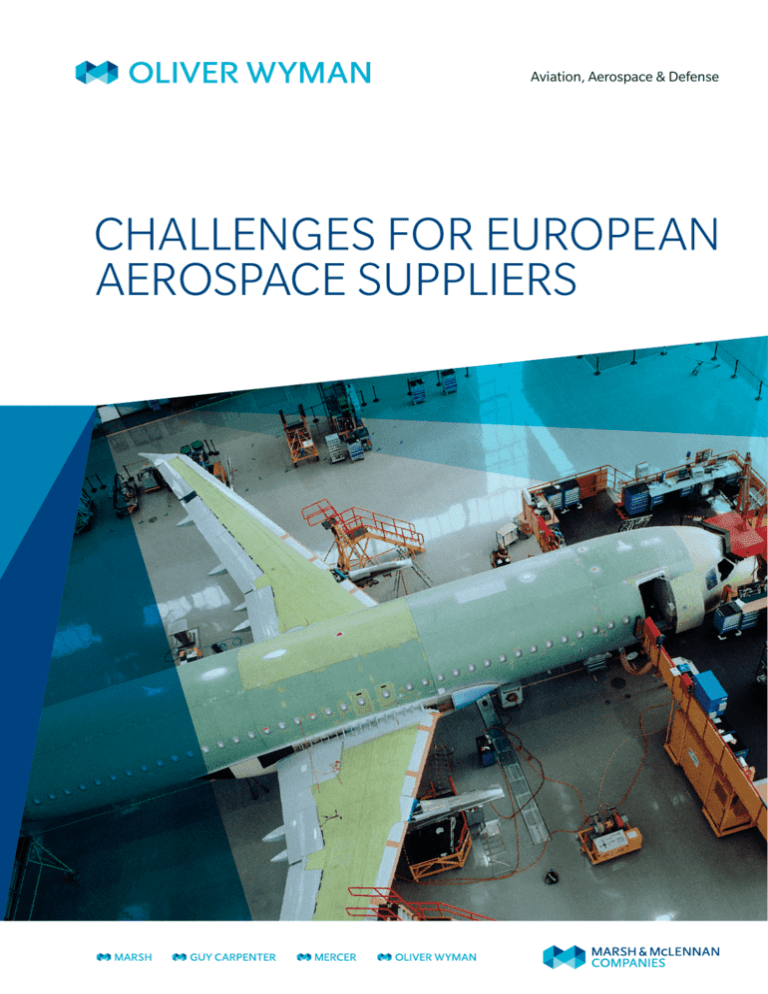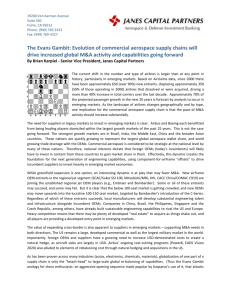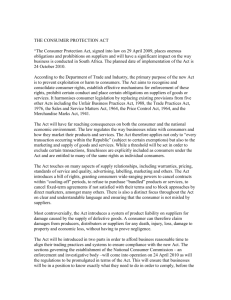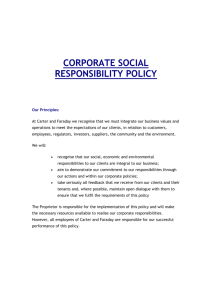
Aviation, Aerospace & Defense
CHALLENGES FOR EUROPEAN
AEROSPACE SUPPLIERS
CONTENTS
INTRODUCTION3
MANAGING GROWTH AND NEW CHALLENGES
4
European aerospace suppliers’ challenges
5
DEVELOPING A ROBUST AND AGILE SUPPLY CHAIN
6
What should OEMs and suppliers do?
8
DEVELOPING THE FOOTPRINT
9
Extending the footprint to new geographies
9
Managing the footprint extension
9
BOOSTING INNOVATION
11
Development of composite materials
11
Toward 100 percent electric aircraft
12
Improving innovation and development
performance15
CONCLUSIONS15
INTRODUCTION
Airlines around the world are ordering new planes and
demanding new technology. As a result, the global
aerospace industry is growing and aerospace suppliers
must become more innovative and flexible to keep up.
The industry faces three main challenges in the next decade,
according to a study conducted by Oliver Wyman of the
European aerospace industry. Suppliers must:
•• Design and develop more complex parts and systems,
with higher technology content, shorter lead times, and
at a competitive cost
•• Extend their supply chain footprint to emerging markets
•• Upgrade production capabilities and share more
financial and operational risks with original
equipment manufacturers
These challenges will have a direct impact on supply chain
management, which thus must become more robust
and agile.
They also come at a time when the industry must deal with
a number of exogenous issues. Market demand is growing
continuously for both original equipment and spare parts,
while airlines are asking for increasing diversity in aircraft
models. The industry faces new competition from emerging
countries, OEMs are creating an international supply base,
and regulators are writing stronger environmental and noise
rules for aircraft.
Oliver Wyman interviewed 40 European senior aerospace
executives at original equipment manufacturers and Tier 1
and Tier 2 suppliers. This study highlights major trends
we uncovered and how aerospace suppliers can react to
generate profitable and long-term sustainable growth.
3
MANAGING GROWTH
AND NEW CHALLENGES
Nine out of ten executives interviewed for
this study are optimistic or very optimistic
about market evolution and demand growth
in the commercial aerospace sector. That’s
no surprise.
During the past 10 years, demand for
commercial aircraft has been gradually
expanding, due to continuous global growth
in demand for passenger and cargo transport,
particularly by air. The BRIC countries, Brazil,
Russia, India, and China, are seeing huge
demand for planes as a result of increasing
population and wealth, and transport in the
Middle East is also growing, as the region
aims to become a hub for air transport.
Aircraft manufacturer forecasts suggest that
global demand for new aircraft in the next 20
years will reach around 36,800 units, which is
20 percent more than during the 1993 to 2013
period. Only around 14,700 of the new aircraft
will replace existing planes; the rest will be
needed for traffic growth.
rolled out to other aircraft to improve costs
and reduce environmental impacts with less
development complexity than would be the
case for new model designs.
New programs are now largely coming from
niche competitors, such as Bombardier,
Embraer, and Mitsubishi, and new entrants,
such as Sukhoi Irkut and COMAC. These
programs offer a different value proposition
to supply chain partners, with higher-value
content and lower-volume contracts.
As these programs grow, new challenges will
emerge for the supply chain. Suppliers will
need time to develop new concepts, recruit
and retain engineers and production staff,
ensure production quality and meet delivery
deadlines, and define the appropriate
manufacturing organizations and supply
chains to satisfy aftermarket demand.
Other external factors also will impact the
supply chain as demand grows. First, OEMs
tend to extend their footprint only to chase
Current large commercial aircraft programs
new growth opportunities, to rebalance
are meeting this demand. For example,
euro and dollar exposure, or to comply
by December 2014, orders for the Airbus
with offset requirements. In these cases,
A320neo had neared 2,700. Existing
programs at Airbus and Boeing are expected manufacturers may require suppliers to
stay close and to adapt their own supplier
to last until 2030, ensuring strong market
network to new geographies. Second,
demand and a high throughput rate
environmental regulations and rising fuel
for the supply chain. For example, the
production rate for the A320 and the Boeing prices have pushed OEMs and suppliers to
develop lighter and less costly products.
737 reached 40 aircraft a month in 2013
Third, facing major project delays and
(Exhibit 1).
greater pressure from their clients, OEMs
As Airbus and Boeing deliver current models, are seeking to share financial risks with their
the development of new aircraft is expected
suppliers. This means that suppliers must
to slow down. Enhancements like those
develop robust in-house legal capabilities to
developed for the 737NG or A320neo will be deal with OEMs.
4
Finally, OEMs increasingly try to cut costs
by rationalizing their supplier base. This
puts strong pressure on suppliers to remain
competitive so that they are not ejected.
EUROPEAN AEROSPACE
SUPPLIERS’ CHALLENGES
To thrive in this new environment,
aerospace suppliers will face three main
challenges over the next decade. They must
develop robust and agile supply chains,
while extending the footprint of their
manufacturing and engineering so as to be
part of a more global supply chain. Suppliers
must in addition take on more innovation and
technology development work for the OEMs.
As a chief executive of a Tier 1 supplier put
it: “Supply chain in aeronautics is all about
choosing the right partners.”
Exhibit 1: Aircraft demand and production rate increase
AIRBUS AND BOEING NET ORDER
NUMBER OF AIRCRAFT BOOKED
3,000
2,000
1,000
Trend
Aircraft
booked
0
2002 2003 2004 2005 2006 2007 2008 2009 2010 2011 2012 2013 2014
A320 AND B737 MONTHLY PRODUCTION RATES
AIRCRAFT/MONTHS
45
35
25
B737
15
A320
2004
2005
2006
2007
2008
2009
2010
2011
2012
2013
2014
Source Airbus and Boeing annual reviews; Oliver Wyman analysis
5
DEVELOPING A ROBUST
AND AGILE SUPPLY CHAIN
Airlines’ growing orders are pushing Airbus
and Boeing to refocus their activities
on assembling, and to outsource the
development of entire systems that they
used to handle internally. This means that
OEMs must accelerate and reinforce their
purchasing processes and supply chain
management and rebalance their risk
profiles. This heavily impacts the entire
supply chain. OEMs’ specifications have
become more complex, with stricter quality
requirements and intellectual property
transfer clauses. Furthermore, R&D and
tools are no longer systematically funded by
OEMs, and contracts include clauses that fix
prices in dollars for the next 10 to 15 years.
In this context, smaller suppliers may not be
able to catch up with legal and contractual
requirements and heavier capital spending,
meaning that consolidation may be a
necessity for many.
For example, Airbus counted just 90 suppliers
for its A350 model in 2012, compared with
around 200 Tier 1 suppliers for its A380 in
2007 (Exhibit 2).
OEMs reinforce this trend by pushing the
larger suppliers to rationalize their own
supply bases, aiming to cut the number of
suppliers by as much as 50 percent. This is
especially rampant in sub-industries where
fragmentation is still high, such as aerostructure components. Public authorities
support such consolidation, either through
existing financing bodies (such as the FSI
or CIRI in France) or by creating dedicated
funds to support consolidation (for
example, France’s Aerofund 1, 2, and 3).
The consolidation of the industry is visible
in many areas, such as the aircraft fastening
market, which counted 14 players 15
years ago in France, compared with only
three today.
Exhibit 2: Number of suppliers for different product models
NUMBER OF
TIER 1 SUPPLIERS
OEM
PRODUCT MODEL
Airbus
A380
200
A350
90
OEM
PRODUCT MODEL
Embraer
EMB 145
EMB 170/190
NUMBER OF SUPPLIERS
NUMBER OF RISK
SHARING SUPPLIERS
350
4
38
16
TIER 1
PRODUCT MODEL
Rolls-Royce
Trent 500
NUMBER OF SUPPLIERS
250
Trent 900
140
Trent 1000
75
Source Aerospace Global Report 2011 IMAP; Usine Nouvelle; Oliver Wyman analysis
6
In addition to consolidation, suppliers must
also rethink their supply chains to compensate
for OEM weakness in planning and spare parts
management. These challenges deeply impact
the relationship between industry players, as
each must integrate more complex activities.
Tier 1 suppliers are now being entrusted with
complete modules and systems by OEMs and
are expected to manage more complexity.
Suppliers are also becoming more involved in
R&D and innovation. This means that they must
grow outside of their core business, extend their
engineering capacities, manage relationships
with new suppliers, and recruit employees with
the right skills to develop whole modules. The
supplier-OEM relationship is shifting from buildto-print to build-to-specs. Risk-sharing schemes
are also expanding, with Tier 1 suppliers taking
on a higher percentage of risk.
An illustration of this trend is Stelia (formerly
Aerolia). The company was created when
Airbus outsourced its nose fuselage parts
manufacturing in 2009. It is now a super Tier 1
supplier, managing entire work packages
and its own value chain. Another example
is Spirit Aero, created in 2005 when Boeing
Commercial Airplanes sold its Wichita,
Kansas division (fuselage and cockpit) to an
investment firm.
Tier 2 and Tier 3 suppliers must also evolve and
work with the larger Tier 1 suppliers to perform
most manufacturing tasks. As Tier 1 suppliers
cannot pass along risks (such as penalties) to
smaller and more fragile suppliers, such risks
will tend to increase quality, cost, and delivery
requirements. Tier 2 and Tier 3 suppliers must
then scramble to accelerate performance,
on-time delivery, and service levels. They do
bear substantial risk of failure, and one failing
supplier can impact the whole program and
generate important financial consequences
for the OEM.
CASE STUDY 1
MODULARIZATION AND WORK
PACKAGE OUTSOURCING
The trend in recent years has been for OEMs to
outsource larger work packages to Tier 1 suppliers.
Both Boeing and Airbus are streamlining their supply
chains to refocus their role as system-integrating
aircraft architects. For instance, Airbus has cut in
half the number of systems and equipment work
packages from the A320 to the A350.
For suppliers, the first step has been to switch to a
kitting phase so as to have enough time to develop
the right internal capacity. This was the case for a
small French supplier (~€30 million in revenue in
2012), a specialist in structural parts. The company
took on significant investment and risk to play
this new role, including creating a dedicated new
engineering department in 2010 to complement its
manufacturing activities.
Suppliers may attempt then to switch from focusing
on kitting to covering a conception phase as
well. There are two limits to the modularization
trend, however:
• OEMs are still eager to personalize modules and
are not willing to give up design control.
• A rift could emerge among Tier 1 suppliers,
as some will be unable to follow the trend and
successfully adapt.
7
WHAT SHOULD OEMS AND
SUPPLIERS DO?
OEMs should help Tier 1, Tier 2, and Tier 3
suppliers deploy manufacturing excellence
initiatives to support the ramp-up in
production and to reduce direct and indirect
costs via lean initiatives. These initiatives aim
to smooth production flows through more
automation, limiting workforce variations.
OEMs should also help Tier 1 suppliers
integrate their new responsibilities as “Super
Tier 1,” especially for the transcription of
specifications and the management of
interfaces with new suppliers.
In addition, OEMs should reinforce their
supply chain risk management capabilities
and operational management of the
supplier base. This is necessary to improve
their selection of supply partners (based
on operational and financial performance
analysis and supply chain robustness) and
to help suppliers mature and survive in
crisis situations.
Suppliers that have implemented these
kinds of initiatives have reached new
levels of on-time delivery, nearing 96 to 97
percent. Now, the challenge is for them to
maintain this level while increasing volume
as demand grows for original equipment and
aftersales markets.
“Securing the supply chain is top priority,”
said Airbus Chief Executive Officer Fabrice
Brégier in February 2013, referring to the
recent increase in production rates and the
necessity to deliver projects on time. He
spoke at a time when many Tier 2 and Tier 3
had failed to anticipate the need to invest
in their production capacity, exposing the
whole supply chain to major risks.
SERVICES
INTEGRATION
Exhibit 3: Companies usually follow one of four patterns to secure their supply chains
Induxial
CONSOLIDATING FORCES
Latecoere – PFW
OEM RESCUE
• Consolidation in 2007 of the activities of seven
SMEs to manufacture as a Tier 1 supplier complete
metallic systems for Airbus, Dassault Aviation,
and Cessna
– Boilermaking, machining, sheet metal work,
wiring, assembly
• PFW Aerospace, an important air and fuel conduit
supplier for the A350 and A380, was acquired by
Airbus in Nov. 2011, to overcome important
financial issues
• Latécoère, the aerostructure supplier, at one
time discussed with Airbus Gp (EADS at that
time) the possibility of merging with other
airframe subsidiaries
Daher
IN-HOUSE SUPPLY CHAIN SERVICES
ThyssenKrupp
THIRD PARTY LOGISTICS
• Daher developed an Integrated Industrial Support
service that secures its entire supply chain from
supplier plants to the OEM assembly line
– Tracking/tracing of components, transportation
and logistics issues, spare parts and stocks,
customs issues, etc.
• ThyssenKrupp Aerospace offers logistics services
to aerospace suppliers, which include:
– Storage, picking, cutting, inspection and
packing located close to the customer, delivery
– Complete turnkey solutions integrating all the
services above
INTERNAL
EXTERNAL
8
DEVELOPING THE FOOTPRINT
EXTENDING THE
FOOTPRINT TO
NEW GEOGRAPHIES
In recent years, OEMs have expanded their
footprint to new countries. Airbus Tianjin’s
final assembly line began operations in
2008, and as of May 2013, the Chinese
operation had produced 126 A320 family
aircraft. Airbus is planning a US A320
final assembly facility by 2015 in Mobile,
Alabama. And Bombardier had planned
to extend manufacturing operations by
opening two Q400 final assembly lines, one
in Russia and one in China. Recent events
in the Ukraine put the project with Rostec
in Russia on hold, but the Chinese project
is still under discussion. In addition, OEMs
in emerging countries are becoming more
active, with Russia’s Sukhoi, China’s COMAC,
and Brazil’s Embraer introducing more small
commercial aircraft.
To remain close to manufacturing
operations, Tier 1 suppliers have also
expanded their operations to the same
countries as OEMs. For example, Asia has
become an important region, especially for
Tier 1 suppliers such as Safran, Thales, and
Zodiac (Exhibit 4). Mexico is becoming a
low-cost manufacturing center for North
American suppliers, with more than $5
billion in exports through more than 270
aerospace companies operating there.
European suppliers are also settling in
Mexico, attracted by the North American
market. In 2008, for instance, Daher opened
a plant in Mexico in order to penetrate the
Boeing market, instead of opening the plant
in Asia.
Three key challenges have surfaced with
this extension of the aerospace footprint
to emerging geographies. First, local
governments in emerging markets are
imposing offset requirements, pushing
OEMs and Tier 1 suppliers to rely on a local
supply chain. Second, many suppliers
doubt that OEMs’ demand in emerging
countries will justify the investment. Finally,
aerospace companies face more technical and
quality issues when extending to emerging
geographies: Initial scrap rates are higher due
to poor preparation for moving operations
and there are risks of technical inconsistencies
linked to an increased number of “layers” of
suppliers (e.g., batteries on the B787).
MANAGING THE
FOOTPRINT EXTENSION
To avoid cash drains or quality issues, most
aerospace suppliers have kept product
development in their home countries for
now, and have outsourced manufacturing
capacities only in emerging geographies.
Comprehensive local training has become
mandatory. Training programs should
9
resemble as closely as possible suppliers’
training programs at home. A few companies
even send trainers from their home
countries to teach the first group of local
employees. Some companies also bring in
employees from their home countries to
help launch operations in remote facilities,
so as to help with knowledge and culture
transfer. It’s also crucial to closely monitor
outsourced activities. Western engineers
sometimes monitor the launch of the first
production sets to implement and ensure
quality requirements.
Some suppliers prefer to bypass the
challenges of setting up operations in
faraway countries, and opt to add production
facilities in countries closer to home. Some
European suppliers favor adding lower-cost
production in North Africa rather than in Asia,
as rising wages, productivity differences, and
volatility of transportation costs make Asia
less attractive. As an illustration, the number
of employees in the aerospace supply chain
in Morocco rose from around 4,000 in 2004
to more than 9,000 in 2012.
Exhibit 4: Main European aerospace investments in China over the past 20 years
• Zodiac Aerospace (2011)
• Airbus (2012)
HARBIN
SHENYANG
• Rolls-Royce (2013)
• Zodiac Aerospace (1994)
• Thales (2006)
BEIJING
• Zodiac Aerospace (2005)
• Airbus (2005)
• Rolls-Royce (1996)
• Safran (2010)
TIANJIN
XI’AN
• Safran (2008)
• Safran (2011)
SUZHOU
SHANGHAI
Source Catalyst Global Aerospace Sector 2012, Safran reports, Airbus reports, Usine Nouvelle
10
BOOSTING INNOVATION
The aerospace industry is constantly
looking to adopt innovative ways to
reduce aircraft weight and cost, and to
meet environmental regulations. Yet, most
suppliers find it challenging to improve
their innovation performance and capacity,
including in composite materials and
aircraft electrification.
DEVELOPMENT OF
COMPOSITE MATERIALS
The advantages of composites have been
well understood for decades, but low energy
costs blocked their introduction. The rise
in jet fuel prices however pushed aircraft
manufacturers to improve aircraft efficiency
and to increase the use of composites in new
twin-aisle aircraft.
OEMs now estimate every 1 kilogram of
weight reduction translates into $1,000 in
cost savings for short to mid-range flights.
The introduction of composite materials
in aircraft has been an ongoing trend,
stimulated by several factors, including
material price, fuel price, and innovation in
carbon’s properties (such as resistance to
fatigue and corrosion).
Composite materials are being developed
for all sections of the aircraft. The most
common target within the industry is to
achieve 50 percent composite composition
Exhibit 5: Aircraft composite usage compared to jet fuel price
COMPOSITE STRUCTURAL WEIGHT
IN PERCENTAGE
60
PRICE PER GALLON
FEBRUARY 2000-2001, IN US$
3
A350-900 XWB
Boeing 787
40
2
A400M
A380
20
1
A340-300
A320
Price per gallon
A300
0
1970
A310-320
1980
A340-600
1990 2000
2002 2004
FIRST FLIGHT
0
2006
2008
2010
Composite
structural weight
2012
Source Oliver Wyman analysis
11
and 20 percent weight reduction by 2020.
Recent programs have demonstrated huge
progress with the A350 XWB’s structure
at 53 percent composite and the B787 at
50 percent. Thanks to this new generation
of twin-aisle jets, composite demand is
expected to triple over the next 20 years.
To ensure a presence in this market, most
aerospace suppliers are heavily investing
in R&D and have been acquiring capacities
from external companies. For instance, UTC
Aerospace Systems acquired composite
company CTG in 2012 to develop a
composite transmission shaft.
Still, the return on investment for composite
components has not yet been proven. The
material is significantly more expensive
to produce than aluminum. For example,
thermoset composite materials cost about
15 times and thermoplastics cost around 75
times what it costs to produce the equivalent
in machined aluminum. Development and
tooling costs are higher as well, while the
difference in the total cost of ownership for
aircraft operators is not as significant.
strikes and soundproofing. Reliability and
repairability is yet to be proven on a large
scale with composites, which are making
their debut in civilian aircraft structural
parts on the Boeing 787.
Moreover, the recycling of composite
components is still an issue, as no solution is
foreseen for now, especially for the thermoset
composites which are used in aerospace.
The challenge for the next 15 to 20 years will
be to improve composite material profitability
by reducing related costs and integrating the
value chain to boost flexibility.
TOWARD 100 PERCENT
ELECTRIC AIRCRAFT
Electrification of aircraft systems is the
second innovation challenge. Replacing
hydraulic and pneumatic power will reduce
power consumption and noise pollution.
Above all, electrification reduces system
weight, thus cutting fuel consumption.
The supply chain for composite materials
remains too long. There are presently six
to seven suppliers from the chain’s start to
the OEM. Furthermore, there are too many
steps for this supply chain to be reactive and
flexible, and each link in the supply chain
adds its own mark-up, boosting total cost
(see Case Study 2).
New aircraft programs are integrating an
increasing number of electrical systems. On
the A380 for instance, thrust reversers and
backup flight control actuators have been
developed with electrical power. On the
Boeing 787, brakes, engine start-up, and
cabin pressurization are now electrical. The
Airbus A380 uses 0.8 megawatts of electricity,
while the Boeing 787 uses 1.5 megawatts.
The technology is not yet mature and
there are still problems that can cause
maintenance issues, such as lightning
The next stage will be the electrification of
systems to pressurize, heat, and cool aircraft
cabins and to power water pumps.
12
CASE STUDY 2
AEROSPACE COMPOSITE TRENDS
Due to aerospace specificities (large parts, high
performance, detailed certification processes, and
supply security requirements), OEMs favor major,
partially integrated suppliers, and long-term contracts
of 20 years or more. OEMs facilitated the consolidation
and emergence of Hexcel Corp., Cytec Industries
Inc., and Toray Industries Inc. as integrated suppliers
controlling 90 percent of the market for aero preimpregnated (pre-preg) composite fibers reinforced
with resin. Pre-preg producers are capturing most of
the value thanks to complex formulations that remain
trade secrets. Parts manufacturers are limited to a
lower-value assembly and risk sharing role with OEMs.
Exhibit 6: Composite industry value chain
RAW MATERIALS
WEAVING
PRE-PREG
PART MANUF.
CARBON FIBER
SGL Carbon
Sigmatex
AKSA
Saertex
Hexcel
60%
Cytec
20%
OEM
DRIVERS
Set specifications
and certify suppliers
Boeing
Pre-preg
Airbus
Toray
10%
TenCate
GKN
General Dynamics
Northrop Grumman
BAE Systems
RESINS
Huntsman
Monopolistic
DOW
TP players
to emerge
Alenia Aeronautica
Resins
Spirit Aerosystems
…
Additives
FOLLOWERS
Comac
Bombardier
Embraer
X%
Production share
Challengers
Secondary
sourcing
13
Another objective is electrifying how planes
move on the ground. Most aircraft currently
taxi their way around airports using thrust
from their engines, consuming much fuel
along the way. Alternative taxiing solutions
are being developed today, either on-board
the aircraft or ground-based (non-flyable),
applying power to the nose wheel or to main
wheels, and addressing power sources (APU
or fuel cells). Airlines stand to save up to
four percent of total block fuel consumption,
and will make gains in maintenance (brakes,
engines, etc.), with total savings estimated
to reach $200,000 per narrow body
aircraft annually.
The next electrification frontier will be
propulsion systems. During critical flight
phases, alternative energy could help
reduce fuel consumption and thus operating
costs. In 2013, Airbus Group, Siemens, and
Diamond Aircraft entered into a long-term
research partnership to introduce hybrid
drive systems.
We expect the quest for 100 percent electric
aircraft will continue for OEMs, but unlike
the evolutionary approach adopted on the
A350 and B787, the next stage will require
a complete redesign of aircraft systems.
Suppliers are thus positioning themselves to
design complete electrical systems, including
power generation and distribution systems.
For instance, Safran has had responsibility for
the electrical systems on the Embraer KC390
since 2012.
CASE STUDY 3
BOOSTING INNOVATION CAPACITIES
OF SMALL COMPANIES
Safran began operating its Composite Center in
2013 in Itteville, France, following a €50 million
investment. It combines research, engineering, and
prototype manufacturing facilities, all dedicated
to composites. The objectives of the center
are threefold:
• Continuing work on innovative composite
technologies, such as 3-D weaving
• Exploring new research paths, including higher
temperature-resistant resins, by collaborating
with academia, research labs, specialized
start-ups, etc.
• Facilitating the circulation of these technologies
across all Safran companies
The center is located next to the Safran Herakles
plant, which specializes in the manufacturing
of thermoset composites, in order to have idea
generation and product manufacturing capabilities
close to one another.
Projects are led in cooperation with:
• Snecma: Open rotor engine blades, engine
parts, and accessory support for the LEAP engine
• Techspace Aero: Low-pressure
compressor casings
• Sagem: Housings
• Hispano Suiza: Transmission shafts
14
IMPROVING INNOVATION
AND DEVELOPMENT
PERFORMANCE
To meet OEM expectations in line with
these innovative trends, suppliers will need
to develop their ability to innovate and may
need to make fundamental changes to the
way they work. Suppliers can introduce
open innovation initiatives with start-ups
and companies from other industries to
help generate innovative concepts and
improve their portfolio management
process (see Case Study 3).
They can create a design authority,
composed of senior experts, to monitor the
engineering team’s progress and guide the
group toward quality, cost, and delivery
requirements. The design authority would
be able to implement a design freeze
when necessary.
Suppliers also can monitor engineering
progress by tightening the management
of maturity gates during the project
development process.
Another option is to employ a functional
architecture approach. As systems are
more and more interlinked, a comprehensive
functional architecture approach can be
an effective way to manage interfaces
between systems.
Suppliers can increase testing relevance
by continuing to reduce physical tests and
favoring upfront digital simulation instead.
3-D printed prototypes also can help reduce
development time.
Finally, as the production pace quickens,
suppliers can adapt their organizations by
rebalancing staff, swiftly moving capacity
from development to production ramp-up
as needed.
CONCLUSIONS
The aerospace industry’s supply chain is facing new challenges. To ensure survival, suppliers
need to take significant measures to:
•• Manage growth and cope with accelerating production ramp-up, while integrating new
technologies such as composites, electrification, and new generation engines
•• Ensure supply chain agility and robustness, as OEMs are now outsourcing
complete modules
•• Manage footprint extension to new geographies, following both the development of
emerging countries’ OEMs and initiatives from traditional OEMs to reduce costs by
relocating a portion of their activities
•• Boost innovation capacities to support OEMs in their efforts to reduce fuel consumption
by 50 percent in the mid-term
In addition to these challenges, another emerging issue will require industry players’
attention: the chase for talent and resources. Companies’ capacity to attract, retain, and
develop talent, both in their traditional geographies and in new targeted areas, will indeed
be crucial to their continued success.
ABOUT OLIVER WYMAN
Oliver Wyman is a global leader in management consulting. With offices in 50+ cities across 25 countries, Oliver Wyman combines
deep industry knowledge with specialized expertise in strategy, operations, risk management, and organization transformation.
The firm’s 3,000 professionals help clients improve their operations and risk profiles and accelerate their organizational performance
to seize the most attractive opportunities. Oliver Wyman is a wholly owned subsidiary of Marsh & McLennan Companies [NYSE: MMC].
For more information, visit www.oliverwyman.com. Follow Oliver Wyman on Twitter@OliverWyman.
Oliver Wyman has built up experience serving leading clients throughout the civil and military aerospace value chain, covering a wide
array of topics such as R&D performance, industrial footprint strategy, manufacturing excellence projects and project turnaround.
www.oliverwyman.com
BERNARD BIRCHLER
Partner
bernard.birchler@oliverwyman.com
SÉBASTIEN MAIRE
Partner
sebastien.maire@oliverwyman.com
JÉRÔME WEILL
Partner
jerome.weill@oliverwyman.com
ERIC CIAMPI
Principal
eric.ciampi@oliverwyman.com
GEOFF MURRAY
Partner
geoff.murray@oliverwyman.com
ARCHAG TOULOUMIAN
Engagement Manager
archag.touloumian@oliverwyman.com
Copyright © 2015 Oliver Wyman
All rights reserved. This report may not be reproduced or redistributed, in whole or in part, without the written permission of Oliver Wyman and
Oliver Wyman accepts no liability whatsoever for the actions of third parties in this respect.
The information and opinions in this report were prepared by Oliver Wyman. This report is not investment advice and should not be relied on for such
advice or as a substitute for consultation with professional accountants, tax, legal or financial advisors. Oliver Wyman has made every effort to use
reliable, up-to-date and comprehensive information and analysis, but all information is provided without warranty of any kind, express or implied.
Oliver Wyman disclaims any responsibility to update the information or conclusions in this report. Oliver Wyman accepts no liability for any loss
arising from any action taken or refrained from as a result of information contained in this report or any reports or sources of information referred
to herein, or for any consequential, special or similar damages even if advised of the possibility of such damages. The report is not an offer to buy
or sell securities or a solicitation of an offer to buy or sell securities. This report may not be sold without the written consent of Oliver Wyman.









